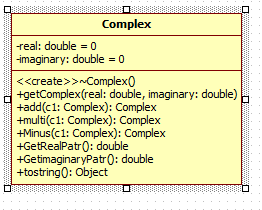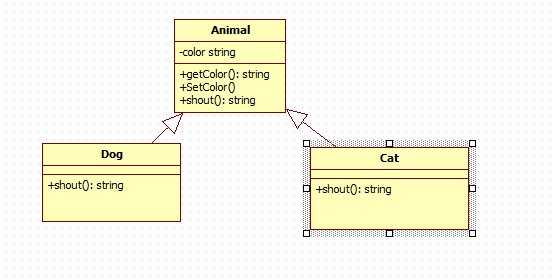北京电子科技学院(BESTI)实验报告
课程:Java程序设计
班级:1452
指导教师:娄嘉鹏
实验日期:2016.04.08
实验名称: Java面向对象程序设计
实验内容:
- 初步掌握单元测试和TDD
- 理解并掌握面向对象三要素:封装、继承、多态
- 初步掌握UML建模
- 熟悉S.O.L.I.D原则
- 了解设计模式
实验目的与要求:
1.使用TDD的方式设计关实现复数类Complex。
2.实验报告中统计自己的PSP(Personal Software Process)时间:
| 步骤 | 耗时 | 百分比 |
|---|---|---|
| 需求分析 | 1h | 20% |
| 设计 | 2h | 40% |
| 代码实现 | 40min | 15% |
| 测试 | 40min | 15% |
| 分析总结 | 30min | 10% |
3.实现要有伪代码,产品代码,测试代码。
4.总结单元测试的好处。
实验内容、步骤与体会
一、实验内容:
(一)使用TDD的方式设计关实现复数类Complex:
1.伪代码
请用户输入第一个复数的实部与虚部:
请用户输入第二个复数的实部与虚部:
这两个复数的和为:
这两个复数的差为:
这两个复数的乘为:
这两个复数的除为:
2.产品代码
public class MyUtil{
public static Complex{
//两个复数相加
double real2 = a.getReal();
double image2 = a.getImage();
double newReal = real + real2;
double newImage = image + image2;
Complex result = new Complex(newReal,newImage);
return result;
//两个复数相减
double real2 = a.getReal();
double image2 = a.getImage();
double newReal = real - real2;
double newImage = image - image2;
Complex result = new Complex(newReal,newImage);
return result;
//两个复数相乘
double real2 = a.getReal();
double image2 = a.getImage();
double newReal = real*real2 - image*image2;
double newImage = image*real2 + real*image2;
Complex result = new Complex(newReal,newImage);
return result;
//两个复数相除
double real2 = a.getReal();
double image2 = a.getImage();
double newReal = (real*real2 + image*image2)/(real2*real2 + image2*image2);
double newImage = (image*real2 - real*image2)/(real2*real2 + image2*image2);
Complex result = new Complex(newReal,newImage);
return result;
}
}
3.测试代码
public class MainClass { // 用于测试复数类
public static void main(String[] args) {
System.out.println("请用户输入第一个复数的实部和虚部:");
Complex data1 = new Complex();
System.out.println("请用户输入第二个复数的实部和虚部:");
Complex data2 = new Complex();
// 以下分别为加减乘除
Complex result_add = data1.add(data2);
Complex result_sub = data1.sub(data2);
Complex result_mul = data1.mul(data2);
Complex result_div = data1.div(data2);
result_add.print();
result_sub.print();
result_mul.print();
result_div.print();
}
}
程序源代码
import java.util.Scanner;
public class Complex { // 复数类
double real; // 实部
double image; // 虚部
Complex(){ // 不带参数的构造方法
Scanner input = new Scanner(System.in);
double real = input.nextDouble();
double image = input.nextDouble();
Complex(real,image);
}
private void Complex(double real, double image) { // 供不带参数的构造方法调用
// TODO Auto-generated method stub
this.real = real;
this.image = image;
}
Complex(double real,double image){ // 带参数的构造方法
this.real = real;
this.image = image;
}
public double getReal() {
return real;
}
public void setReal(double real) {
this.real = real;
}
public double getImage() {
return image;
}
public void setImage(double image) {
this.image = image;
}
Complex add(Complex a){ // 复数相加
double real2 = a.getReal();
double image2 = a.getImage();
double newReal = real + real2;
double newImage = image + image2;
Complex result = new Complex(newReal,newImage);
return result;
}
Complex sub(Complex a){ // 复数相减
double real2 = a.getReal();
double image2 = a.getImage();
double newReal = real - real2;
double newImage = image - image2;
Complex result = new Complex(newReal,newImage);
return result;
}
Complex mul(Complex a){ // 复数相乘
double real2 = a.getReal();
double image2 = a.getImage();
double newReal = real*real2 - image*image2;
double newImage = image*real2 + real*image2;
Complex result = new Complex(newReal,newImage);
return result;
}
Complex div(Complex a){ // 复数相除
double real2 = a.getReal();
double image2 = a.getImage();
double newReal = (real*real2 + image*image2)/(real2*real2 + image2*image2);
double newImage = (image*real2 - real*image2)/(real2*real2 + image2*image2);
Complex result = new Complex(newReal,newImage);
return result;
}
public void print(){ // 输出
if(image > 0){
System.out.println(real + " + " + image + "i");
}else if(image < 0){
System.out.println(real + "" + image + "i");
}else{
System.out.println(real);
}
}
}
public class MainClass { // 用于测试复数类
public static void main(String[] args) {
// TODO Auto-generated method stub
System.out.println("请用户输入第一个复数的实部和虚部:");
Complex data1 = new Complex();
System.out.println("请用户输入第二个复数的实部和虚部:");
Complex data2 = new Complex();
// 以下分别为加减乘除
Complex result_add = data1.add(data2);
Complex result_sub = data1.sub(data2);
Complex result_mul = data1.mul(data2);
Complex result_div = data1.div(data2);
result_add.print();
result_sub.print();
result_mul.print();
result_div.print();
}
}
测试结果:

- 以下是建立的模型:

- 从模型中可以看见在Complex类中定义了如下方法:
首先定义了实部real与虚部imaginary,并赋初值0
- getComplex()方法用于置数
- add()方法用于两个复数相加
- multi()方法用于两个复数相乘
- Minus()方法用于两个复数相减
- GetRealPatr()方法得到实部
- GetimaginaryPatr()方法得到实部
- tostring()方法把复数结合成为a+bi形势的字符串
(二)面向对象三要素
1.抽象
"去粗取精、化繁为简、由表及里、异中求同"。抽象就是抽出事物的本质特征而暂时不考虑他们的细节。对于复杂系统问题人们借助分层次抽象的方法进行问题求解;在抽象的最高层,可以使用问题环境的语言,以概括的方式叙述问题的解。在抽象的较低层,则采用过程化的方式进行描述。在描述问题解时,使用面向问题和面向实现的术语。程序设计中,抽象包括两个方面,一是过程抽象,二是数据抽象。
2.封装、继承与多态
面向对象(Object-Oriented)的三要素包括:封装、继承、多态。过程抽象的结果是函数,数据抽象的结果是抽象数据类型(Abstract Data Type,ADT),类可以作具有继承和多态机制的ADT,数据抽象才是OOP的核心和起源。
OOP三要素的第一个要素是封装,封装就是将数据与相关行为包装在一起以实现信息就隐藏。Java中用类进行封装。
封装实际上使用方法(method)将类的数据隐藏起来,控制用户对类的修改和访问数据的程度,从而带来模块化(Modularity)和信息隐藏(Information hiding)的好处;接口(interface)是封装的准确描述手段。
public abstract class Animal {
private String color;
public String getColor() {
return color;
}
public void setColor(String color) {
this.color = color;
}
public abstract String shout();
}
public class Dog extends Animal{
public String shout(){
return "汪汪";
}
public String toString(){
return "The Dog's color is " + this.getColor() +", and it shouts "+ this.shout() + "!";
}
}
public class Cat extends Animal{
public String shout(){
return "喵喵";
}
public String toString(){
return "The Cat's color is " + this.getColor() +", and it shouts "+ this.shout() + "!";
}
}

3.设计模式初步
(1)S.O.L.I.D原则
·SRP(Single Responsibility Principle,单一职责原则)
·OCP(Open-Closed Principle,开放-封闭原则)
·LSP(Liskov Substitusion Principle,Liskov替换原则)
·ISP(Interface Segregation Principle,接口分离原则)
·DIP(Dependency Inversion Principle,依赖倒置原则)
(2)模式与设计模式
计算机科学中有很多模式:
GRASP模式
分析模式
软件体系结构模式
设计模式:创建型,结构型,行为型
管理模式: The Manager Pool 实现模式
界面设计交互模式
这里面最重要的是设计模式
(3)设计模式实示例
设计模式有四个基本要素:
Pattern name:描述模式,便于交流,存档
Problem:描述何处应用该模式
Solution:描述一个设计的组成元素,不针对特例
Consequence:应用该模式的结果和权衡(trade-offs)
二、单元测试的好处:
-
减少问题出现,提高程序质量,在测试中进行项目,边改边写,可以将自己设计的项目不断优化
-
更快地定位问题出现在哪个模块,提高效率,减少成本,这有助于实现模块的“块内高内聚,块间低耦合”
三、心得体会:
这次实验较第一次实验而言,增加了软件的利用性,不仅要编辑、编译、运行、调试代码,还要建模,单元测试,所以这次实验遇到的最大问题就是软件的使用方面,安装,运行,每一步都有问题,首先是StarUML的安装,在下载完了之后不知道如何安装,好不容易安装好之后发现不能运行,感觉这次实验真的好复杂,有时候在想,不就就是编程嘛,咋就这么麻烦呢,难道编译好代码直接运行代码不行么!也许是自己接触的编程太少太浅显,还没有达到能将编程运用自如的境界,体会不到其中的便利。